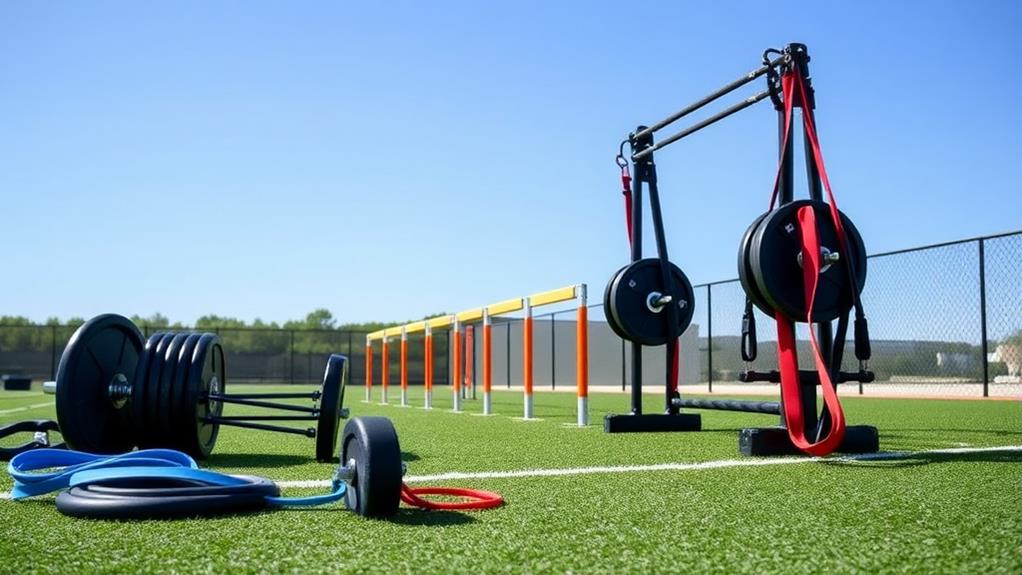Running back training focuses on enhancing agility, strength, and endurance to improve on-field performance while reducing injury risk. Incorporate agility drills, like ladder and cone exercises, to boost quickness and evasion skills; agile athletes are 20% more successful at dodging tackles. Strength training, including compound lifts and plyometrics, can enhance power and speed. Off-season workouts are essential for skill development and mental toughness, as they lead to better performance. Regular assessments of agility and power help track progress. By implementing these techniques, you’ll refine your skills and excel in your role, paving the way for greater success on the field.
Overview of Running Back Training

Running back training focuses on developing the crucial skills you need for success on the field, blending agility, strength, and endurance. As a running back, you’ll tackle a multifaceted role that includes rushing, receiving, and pass protection. To excel, you must engage in a combination of targeted training components.
Agility drills are key, as they help improve speed and quickness, allowing you to dodge defenders effectively. Research shows that agile players enjoy a 20% higher success rate when evading tackles.
Meanwhile, strength training through compound lifts and plyometric exercises enhances your overall athletic performance, with studies indicating that power training can boost your sprint speed by up to 15%.
Additionally, video analysis and performance metrics play a crucial role in your training. They allow you to monitor progress, refine your techniques, and set specific, measurable goals.
This structured approach not only sharpens your skills but also lays the groundwork for injury prevention and tactical planning as you prepare for the season ahead. By committing to an extensive training regimen, you’ll be well-equipped to face the challenges of the game.
Importance of Off-Season Workouts
Off-season workouts are a game-changer for running backs aiming to elevate their performance. This critical period allows you to develop essential skills like dodging tackles and improving pass protection, both foundational for future success on the field. Engaging in off-season workouts isn’t just about maintaining fitness; it’s a key development phase for building strength, agility, and endurance.
A well-structured training routine during this time can greatly enhance your speed, strength, and mental toughness—traits that are essential for executing game-changing plays. Studies show that athletes who commit to consistent off-season training outperform those who don’t, underscoring the importance of this phase in your development as a running back.
Moreover, off-season workouts facilitate recovery and injury prevention, establishing a solid groundwork that translates into better performance during the competitive season. By focusing on strength training and conditioning, you can guarantee that you’re physically prepared to meet the demands of the game.
Understanding the Running Back Position

To excel on the field, you need to grasp the nuances of the running back position. This role demands a unique combination of agility, strength and power, and endurance to navigate the field effectively. As a running back, you’ll execute versatile roles in rushing, receiving, and pass protection.
Key skills include the ability to read plays and find gaps in defenses. You must make quick decisions to exploit opportunities during gameplay, which can be the difference between a touchdown and a tackle. Mental toughness is equally essential; staying focused and resilient under pressure can set apart the best from the rest.
Agility is especially important—studies show that running backs who excel in this area have a 20% higher success rate in dodging defenders. Therefore, incorporating agility training into your regimen is non-negotiable.
Off-season training sets the groundwork for your overall performance, allowing you to hone these specific skills and maintain a competitive edge.
Understanding these aspects of the running back position won’t only improve your gameplay but also enhance your effectiveness on the field. Embrace these elements, and you’ll be well on your way to becoming a top-tier running back.
Key Components of Training Programs
When crafting an effective training program for running backs, you need to focus on several key components that work together to enhance your performance.
Start with strength training, prioritizing compound lifts like squats and the Bench Press, which build foundational strength fundamental for an elite running back. Alongside strength, incorporate agility drills that focus on quick direction changes, helping you evade defenders with ease.
Next, don’t overlook endurance workouts, as they’re essential for maintaining peak performance throughout the game. Power training is another significant aspect; integrating plyometric exercises and Olympic lifts can boost your sprint speed by up to 15%, which is imperative on the field.
Specific drills such as the RB Cone Jump-Cut and Lateral Line Bounding target deceleration, acceleration, and dynamic stabilization.
Lastly, make certain to monitor your progress through performance metrics, regularly testing your agility and power benchmarks. This guarantees your training remains effective and aligned with your specific goals.
Nutrition and Recovery Strategies

Effective nutrition and recovery strategies are essential for maximizing your performance as a running back. A balanced diet rich in proteins, carbohydrates, and healthy fats supports the high energy demands you face during training and recovery.
Understanding carbohydrate sources is vital for maintaining energy levels during intense workouts. To enhance your results, consider implementing meal planning tips that focus on nutrient-dense foods. Pay special attention to meal timing; consuming carbohydrates and protein within 30 minutes post-workout can enhance recovery and replenish glycogen stores effectively.
Hydration strategies are just as important. Make sure to drink adequate fluids before, during, and after workouts to maintain ideal hydration levels. This will noticeably impact your performance on the field.
Incorporating active recovery techniques, such as foam rolling and stretching, can help reduce muscle soreness and promote overall recovery. These practices minimize your risk of injury and prepare your body for the next training session.
Targeted Workouts for Running Backs
Targeted workouts for running backs focus on building explosive power and strength, which are fundamental for your performance on the field. To achieve this, you should incorporate strength training techniques like compound lifts, including squats and deadlifts. These exercises are critical for breaking tackles and enhancing overall on-field performance.
In addition to strength training, agility drills such as ladder and cone drills are essential. These drills help you develop quick direction changes, and studies show that agile players have a 20% higher success rate in dodging defenders.
For lower body explosiveness, integrate plyometric exercises like squat jumps and box jumps into your regimen; these can enhance sprint speed by up to 15%.
Don’t overlook specific drills like the RB Cone Jump-Cut Drill, designed to improve your deceleration and acceleration capabilities, important for maneuvering complex plays during games.
Also, consider incorporating injury prevention strategies and mental conditioning approaches to guarantee your longevity and effectiveness on the field.
Power Training Principles

When you’re training as a running back, explosive strength is key to breaking tackles and enhancing your performance on the field.
Incorporating Olympic lifts and plyometric exercises into your routine can help you develop the power and speed you need to outmaneuver defenders.
Importance of Explosive Strength
Explosive strength is a game-changer for running backs, as it allows you to break tackles and accelerate rapidly from a standstill. This type of explosive power is essential for enhancing your overall performance metrics on the field.
Incorporating strength training into your regimen not only boosts explosive power but also helps prevent injuries by strengthening often-overlooked muscles vital for running. Research shows that power training can increase sprint speed by up to 15%, making it an important element of your training regimen.
To maximize your explosive strength, consider incorporating the following elements into your strength conditioning routine:
- Plyometric Exercises: Such as squat jumps and box jumps, which greatly increase muscle power output.
- Agility Drills: Integrate these into your weekly practice to improve quickness and responsiveness.
- Olympic Lifts: Focus on foundational strength that enhances overall athletic performance and coordination.
- Regular Assessment: Monitor your performance metrics to track improvements and adjust your training as needed.
- Consistency: Experienced players should incorporate power and agility drills regularly, while beginners might start with twice weekly sessions.
Olympic Lifts Benefits
Building on the importance of explosive strength, Olympic lifts serve as a powerful tool for running backs looking to enhance their performance on the field. Incorporating Olympic lift variations, such as the clean and jerk or snatch, can considerably improve your explosive power training.
These lifts target multiple muscle groups, developing the functional strength essential for breaking tackles and accelerating quickly. Research shows that integrating Olympic lifts into your regimen can boost overall athletic performance, potentially increasing your sprint speed by up to 15%.
Additionally, these lifts enhance core stability and balance, helping you maintain control and agility while maneuvering through defenders.
Another key benefit is the improvement in neuromuscular efficiency. By regularly practicing Olympic lifts, you’ll experience quicker reaction times and enhanced performance in high-pressure game situations.
This heightened efficiency allows you to execute explosive movements more effectively, giving you an edge on the field.
Plyometric Training Techniques
Plyometric training techniques are vital for running backs aiming to maximize their power and agility on the field. These explosive movements enhance muscle power output, essential for breaking tackles and improving sprint speed by up to 15%.
Incorporating plyometric drills not only boosts your explosiveness but also enhances agility, with agile players having a 20% higher success rate in dodging tackles.
To effectively implement plyometric training, consider the following:
- Squat jumps for lower body explosiveness
- Box jumps to develop vertical power
- Lateral bounds for side-to-side agility
- Depth jumps to improve reactive strength
- Single-leg hops for balance and coordination
Integrating jump technique analysis into your routine helps refine your form, while plyometric progression strategies guarantee you’re advancing appropriately.
Remember to maintain a low center of gravity during exercises to achieve better balance and quick movements. Additionally, heed injury prevention tips, such as warming up properly and listening to your body, to avoid setbacks.
For experienced players, aim for plyometric sessions once a week, while beginners may benefit from twice weekly sessions.
Recommended Agility and Power Drills
When it comes to running back training, agility and power drills are essential for enhancing your on-field performance.
Incorporating exercises like ladder drills and plyometrics can greatly improve your foot speed, coordination, and explosiveness, allowing you to navigate through defenders with ease.
Importance of Agility Training
Agility training is vital for running backs, as it consistently enhances their ability to navigate the field with speed and precision. Incorporating diverse exercises through cross-training can also contribute markedly to agility and overall athletic performance, as it promotes balanced fitness and reduces injury risks associated with repetitive movements cross-training benefits.
By incorporating various agility training techniques into your routine, you’ll experience notable agility training benefits, such as improved foot speed, coordination, and overall performance. A consistent agility training frequency is essential to maximize these benefits and refine your skills.
To elevate your agility training, consider including the following drills:
- Ladder Drills: Enhance foot speed and coordination for quick cuts.
- Cone Drills: Improve lateral movement and acceleration to navigate defenders.
- Shuttle Runs: Develop quickness and endurance for sustained performance.
- Hurdle Drills: Promote explosive takeoffs and landing control for dynamic movements.
- Reaction Drills: Sharpen response time to unexpected movements and defensive shifts.
Incorporating these drills into your training regimen won’t only boost your agility but also prepare you to adapt quickly during games.
Effective Power Drills
To excel as a running back, pairing agility training with effective power drills can greatly enhance your performance on the field.
Integrating power drill variations like squat jumps and box jumps into your routine will markedly boost your lower body explosiveness. This explosiveness is essential for breaking tackles and gaining critical yardage during games.
Incorporating resistance training integration, such as resistance band sprints, can also improve your acceleration and sprint mechanics. These techniques are important for enhancing your overall speed, allowing you to outpace defenders effectively.
Additionally, explosive movement techniques are fundamental when performing drills. For example, using cone drills can enhance your lateral movement and acceleration, which helps you evade defenders during plays.
Shuttle runs also develop your quickness and endurance, ensuring you maintain performance throughout the game.
Measuring Performance Improvements
Measuring performance improvements in agility and power is essential for any aspiring running back. By utilizing effective performance tracking methods, you can quantify your progress and fine-tune your training regimen. Key metrics to monitor include 40-yard dash times, vertical leap height, and shuttle run completion times. These insights will help you identify areas for improvement.
Incorporating agility assessment tools and power measurement techniques into your training can lead to significant advancements. Consider the following drills to enhance your performance:
- Ladder drills for foot speed
- Cone drills to improve quickness
- Squat jumps to boost explosive strength
- Box jumps for overall power
- Video analysis for technique refinement
Regularly implementing these drills can yield an average improvement of 10-20% in agility and up to 15% in sprint speed.
Setting specific benchmarks, like completing a drill within a set time, not only motivates you but also offers clear indicators of your progress. By taking a structured approach to measuring your performance improvements, you’ll be on your way to becoming a more agile and powerful running back.
Monitoring Progress and Performance
Regularly monitoring progress and performance is essential for any running back aiming to improve their skills. You should assess key performance metrics, like sprint times, agility test results, and strength benchmarks, to guarantee you’re making strides in your training. Performance analytics can help you identify trends and areas needing improvement.
Utilizing video analysis is a smart way to spot technique flaws. These insights allow you to make targeted adjustments in your workouts. Setting specific, measurable goals—like reducing your 40-yard dash time by 0.2 seconds—can boost your motivation and focus.
Incorporating training feedback from coaches after drills and workouts further refines your techniques and strategies. Their insights can lead to better training outcomes and help you stay on track.
Regularly testing agility benchmarks, such as shuttle runs, and power measurements like vertical jumps every few weeks guarantees you’re consistently tracking your progress. This approach helps tailor your training programs to your individual needs, ultimately leading to improved performance on the field.
Conclusion
To sum up, effective running back training combines strength, agility, and strategic nutrition, all tailored to elevate your performance on the field. Picture yourself bursting through defenses, powered by off-season workouts that sharpen your skills. Embrace the grind of targeted drills and recovery strategies, knowing each rep brings you closer to your peak. By staying committed to your training program, you’ll not only enhance your abilities but also fuel your passion for the game, making every moment count.

